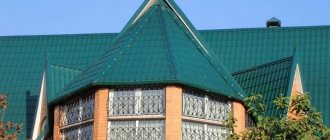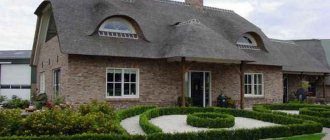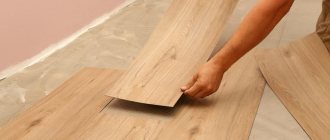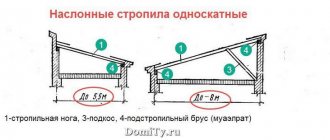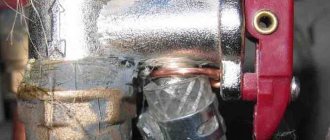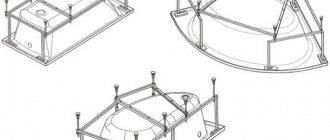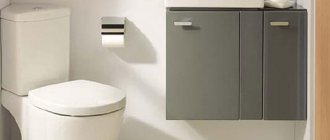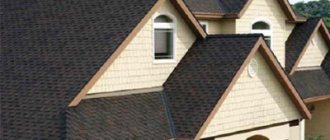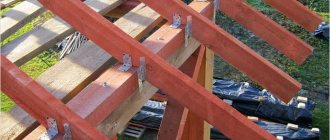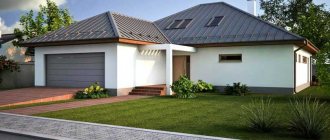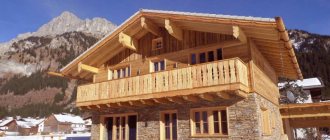The hipped roof cannot be called widespread - it cannot be compared in popularity with ordinary gable and hip roofs. Especially if we are not talking about gazebos, but about private houses. But it is not at all rare. Hip roofing has its own unique features that make it an excellent choice in a number of situations. And this despite its complexity.
These features, the nuances of installing hipped roofs and what they are all about are discussed below.
Two-story houses
By installing a hip roof, the owners of a private two-story house receive a beautiful and practical roof, under which an additional floor appears for living.
Photo: eaglemetalsmfg.com
A hip structure is a variation of a gable roof, in which two slopes are trapezoidal in shape, and the other two are triangular.
All slopes of a hip or half-hip roof usually have a steep slope, so this design can withstand heavy rains and snowfalls. Such roofs are given a colorful eco-ambiance using natural coverings: reed (reed), tile, slate or metal.
One of the varieties of hip roofing is a half-hip Dutch roof with truncated triangular slopes. The photo shows a private house of modern design with bitumen roofing, creating the illusion of natural tiles.
See also: Beautiful roofs of private houses: photos, design options, views
Creating a rafter frame
The prepared drawing of a hipped roof must contain all the parameters and dimensions of the purlins and slopes, and the angles of inclination. Using them, it’s easy to calculate the required size of rafters, depth and distance between cuts.
All of them must be transferred to a wooden block. Before starting work, you need to check the condition of the boards so that there are no bends, grooves, or cracks on them.
Then the work continues according to a certain scheme:
- First, one rafter is cut out. It’s better to check it right away on the roof to see if it’s suitable or not. If there are errors, they should be corrected. All the rest are made from this rafter. The amount needed will depend on the area of the house and the angle of inclination.
- 4 row rafters are being installed per house. If they fit well, then you need to install the ridge and screw the prepared rafters to it. First of all, the outer bars are fastened, then, using a rope, the position of the remaining ones is determined. It is important that the rafter legs are in the same plane.
- Corner rafters are cut according to the drawing. Since they are long, you will have to extend the boards. This element will not be strong, so the bending weight is reduced.
- A sprengel is installed under the slanted rafters, which will relieve the load and will firmly hold the structure in side winds. For stability, they are supported by struts.
- Stretch the rope along the entire bottom of the eaves and place the remaining rafters. Next you need to outline the corner cuts, either using a template or using a triangle.
- All that remains is to screw the sheathing on. The distance between steps depends on the roofing material.
The film does not spread under the grille if soft material is used for the roof. Metal tiles require certain step sizes on the sheathing: on the first two bars 30 centimeters, and then 35 cm each. All boards are attached to the ridge so that a metal ridge element can be installed on them.
- If the rafters are installed correctly, then the counter-lattice will not need to be leveled.
- The roof is installed using the technologies established by the manufacturers.
- If you plan to install ventilation hatches and chimneys in the roof, you should purchase additional elements to create a seal at the joints.
- They come with the roofing material. The gutter for water drainage is attached after hemming. Install it at a slight angle so that there is a stack.
The complexity of installing a hipped roof is compensated by the high-quality characteristics, as well as the resulting design. You can make such a roof yourself if you carefully study the entire structure and the purpose of its elements.
One-story houses
Photo: dallasmetalroofs.com
A laconic silver galvanized seam roof will successfully complement the design of a one-story house with facades made of variegated red brick.
All types of hip roofs look much more original than a conventional gable roof, but the costs of materials and installation will be impressive. Especially if the cottage consists of several living spaces, and the roof itself is complex in configuration, as you see in the photo.
A hip roof allows you to significantly expand the useful space of the house and equip a comfortable bedroom, office, library or nursery in the attic.
Photo: muellerinc.com
Hip roofing demonstrates increased strength under significant wind loads. If you live in a flat region and your house is located in an open area, then such a roof will be the best option.
Compared to a gable structure, a hip roof is a more rational option for arranging an attic: both with dormer windows and with window openings in the plane of the roof covering. It is precisely this, more economical option with windows embedded in the slopes that is shown in the photo of a wooden house with a slate hip roof.
See also: Beautiful brick cottages: 60 photo ideas
Advantages and disadvantages
The above photos of hip roof options show their obvious feature - the presence of four slopes that completely cover the house.
This factor provides several advantages:
- High security. This design prevents wind from entering. Moisture, ultraviolet radiation.
- Durability. Homes and coverings.
- Practicality. Under such flooring there is a large space that can be used as a room.
- Illumination. Several attic windows will add light.
- Design. Variations in coverage and the possibility of installing window openings on all sides will give the estate a special chic.
However, it is worth remembering the disadvantages: high price, complex installation and durability.
Mansard roofs
A hip roof with an attic is ideal if you want to rationally use the roof space.
The tandem of dark-colored hip and half-hip roofs beautifully sets off the white facades of the half-timbered structure.
Arranging an attic with dormer windows will allow you to place several bright and spacious living rooms under the roof.
An attic can be provided not only under the hip roof of the main building, but also above an extension to the house, for example, above a garage.
If you decide to build a budget house in the English style, then it is best to use clinker or decorative stone to decorate the facades, and cover the hip roof with a material that imitates ceramic tiles.
See also: Beautiful mansard roofs of private houses: photos, design examples
Construction of a roof truss system with four slopes
Here is the simplest example of building a standard hip roof for a small country house:
Stage I. Planning and design
Before making a hipped roof, be sure to think through all its details, down to the smallest detail. Be sure to build even the simplest hip roof structure according to a ready-made drawing. The fact is that the finished gable roof has almost noticeable defects and distortions, but if you make a mistake somewhere in the construction of the same hip or hip roof, then the diagonal rafters simply will not meet at the ridge and it will be extremely difficult to correct this.
Therefore, if you know special programs, create a 3D model of the future roof directly in them, and if not, then just prepare a detailed drawing and it’s good if a professional helps you with this. All the details of such a roof must be calculated - down to the smallest detail!
By the way, today it is quite fashionable to make not only the roof hipped, but also its individual functional elements:
Stage II. Preparation of structural elements
So, if you have taken a ready-made roof drawing or sketched it yourself and are confident in the future quality, it’s time to prepare the necessary elements of the rafter system. And to do this, first let’s figure out how they are called correctly.
So, the first thing you have to take care of before building a hip roof is the Mauerlat . This is a square or rectangular beam that you will lay on the top of the walls around the entire perimeter of the house. It will become a support for the rafters, which will transfer the load to it, and it is this board that will evenly distribute the weight of the entire roof onto the walls of the house and the foundation. The ideal option is to use a beam with a section of 15 by 10 cm as a mauerlat.
Next, you will build the rafter legs - this is the main element that will create the slope of the roof. Standard rafters are made from boards 50 by 150 mm, and diagonal ones - 100 by 150 mm.
You will also need ties, the main task of which is to prevent the rafter legs from moving to the sides. You will fix the puffs themselves and connect them with the lower ends, and for this, stock up on boards measuring 50 by 150 meters.
But from above, both the diagonal rafter legs and the standard rafters will converge and be secured to each other in the ridge . To do this, take a beam 150 by 100 mm.
Next, in the center of the two opposite sides there should be a transverse beam - a bench , which serves as a support for the racks, and they, in turn, support the ridge girder. A timber with a cross section of 100 by 100 mm or 100 by 150 mm is suitable for this purpose.
The slopes will become a support for the rafters, which prevents them from moving. You should install them at an angle to the stand; to do this, take the same material as for the bench.
Next, an important detail will be the rack - the vertical element of the roof frame. It will serve as a support for the skate. Make it from the same material as the Mauerlat.
Don't forget also about the wind board - this is a horizontal element that connects all the lower ends of the rafters together. You will need to nail it to the rafters along the inner perimeter of the roof and in this way emphasize the line of the slope. A 100 by 50 mm board is suitable for this purpose.
But for the outside you will need another board - filly , made of the same material. This board received such a strange name from the times when it was carved in the form of horse faces.
But the most unusual and complex element of a hipped roof is the truss , which gives rigidity to the entire structure. Its main task is to connect all horizontal and vertical elements. It is also mounted at an angle, and is made of 100 by 100 mm timber:
And finally, if we are talking specifically about a hip roof, then the only element that is present exclusively in hip roofs is spigots . They are shortened rafters that rest on a diagonal rafter leg. You can make them from a 50 by 150 mm board.
In life, all these elements look like this:
Also think about insulation, waterproofing film and additional roofing elements:
Stage III. Installation of attic floor
Often the headstocks of hanging rafters or hangers, which work in tension in a hip roof, must be made of steel. To do this, special wooden purlins are suspended perpendicularly to the clamps of the wooden rafters.
And wooden beams are suspended perpendicular to the purlins, after which beamless lightweight fillings are laid between them. Therefore, if you want to reduce the roof load on the hanging rafters or roof truss, you need to choose suspended floor structures.
For steel trusses, the suspended ceiling must be made fireproof, using steel beams. Prefabricated reinforced concrete slabs should be laid between such beams, and light insulation should be placed on them. To increase the fire resistance and durability of such load-bearing structures, they must be made of reinforced concrete. Moreover, it is better to make the most reinforced concrete load-bearing structures from large-sized prefabricated panels, so as not to take risks.
Stage IV. Installation of ridge girder
When calculating the ridge run, take into account the following nuances:
- If the building has permanent longitudinal walls, or at least two rows of internal pillars, then two purlins are made. At the same time, many rafter structures can be composite along their length, and crossbars are used to increase rigidity.
- If the building does not have internal supports, then it will not be possible to make inclined rafters here. Therefore, special construction trusses are used, to which the attic floor is simply suspended. In this case, the rods, which are located along the upper contour of the trusses, form the upper chord of the construction truss, and along the lower contour - the lower chord. The truss lattice itself now forms vertical rods and braces - inclined rods that are located between the upper and lower chords. Moreover, such trusses are not necessarily made only of wood; on the contrary, steel reinforced concrete ones are quite popular today. During the construction process, the trusses are installed at a distance of 4-6 meters from each other. The simplest version of such trusses are truss trusses, which consist of rafter legs, a vertical suspension, headstock and tie rods.
- If the width of the building is large enough, construction trusses or truss supports are used during installation. But then the attic floor cannot be covered with beams that will rest on the walls alone. Such a structure must be suspended on steel clamps to the lower chord of the truss, or to a tie, in order to thus form suspended ceilings.
This photo illustration clearly shows exactly how the rafters need to be attached to the ridge and ridges:
Roof with dormer window
Most often, dormer windows in the attic are covered with a gable roof - this design harmonizes well with the hip roof of the house, provided that the parallel slopes have the same slope.
The contrasting finish of the dormers allows them to stand out against the background of the roofing.
To make the attic more comfortable, dormer windows are often combined with balconies.
Dormer windows can play the role of an expressive accent on the roof, especially if they have a semicircular shape.
Dormers of varying sizes on the gables are a distinctive feature of European-style hip roof and mansard houses.
Do-it-yourself roof installation
The construction of a hipped roof involves several stages:
- calculations and design;
- preparation of building materials;
- preparation of the base;
- construction of rafter frame and sheathing elements;
- installation of a roofing pie (steam, heat, waterproofing);
- roof covering.
We recommend that you look at our other articles on how to properly build a hipped roof with your own hands, including with an attic.
From the video you will learn about the nuances of installing a hipped roof:
Correct calculation of basic parameters
Having decided on the type of hipped roof, we proceed directly to calculating its main parameters.
These include the angle of the rafters and the height of the ridge truss. The first parameter is for reference only. It is determined based on the tabular data of SNiP 2.01.07-85, using standard snow and wind loads with reference to the location of the house construction according to the SNiP map.
Having determined the minimum angle of inclination, the height of the tent or ridge girder is obtained in the drawing. You can use the Internet and select the dimensions of lumber profiles (sections) for the manufacture of rafter system elements based on a similar project. You can learn more about the nuances of calculating a pitched roof in a separate material.
Construction of the rafter system
Installation of the rafter frame occurs in the following order:
- rest the central crossbar on the mauerlat of the opposite walls, where the hips will rest;
- racks are installed on the central girder, the upper ends of which are connected with a ridge girder;
- diagonal (sloping) rafters are supported on the ends of the ridge, the frames of future roof slopes are filled with frames and ordinary rafters;
- install reinforcing elements: racks, braces and trusses.
Attention. Only after a thorough check of the reliability and strength of the rafter frame do they move on to installing counter-lattice, sheathing and continuous sheathing with boards or timber. At the same time, they are installing skylights. After this, they begin laying the roofing.
Houses with a bay window
A bay window often becomes not only a spectacular facade element, but also allows you to create a cozy and well-lit area in the living room, dining room or bedroom.
To cover the semicircular bay window protruding beyond the facade, hipped and conical structures are used, which are in perfect harmony with the hip roof.
The bay window often serves as a kind of “core” on which all the floors of the house are “strung,” as in the photo of this modern cottage with a cascading hip roof.
Rectangle or square
It doesn’t matter what kind of house it is, frame, aerated concrete or brick, first of all you need to pay attention to the shape and size of the box. This plays a significant role in determining the type of hip roof.
If the box is a square, then a hip roof would be the ideal option. It is often chosen for large houses measuring 10x10 or 12x12. Although, it looks no less attractive on small buildings measuring 8x8. And if you want to lengthen the square house, under the overhang of the hip roof, you can organize the construction of an extension with a pitched roof. Even if the house box is not square, you can still build a hip roof, the main thing is that the building has the correct polygon shape.
A hip roof will not work for a rectangular house. Here you need to choose a preference between other types of hip roofing.
Hip hip roofs
Hip-type hipped roofing is a traditional option for English Tudor-style houses. This architecture is distinguished by a harmonious combination of brickwork, half-timbering and natural roofing in the form of ceramic or slate tiles.
In addition to the impressive hip roof, English Tudor architecture is characterized by multi-level triangular gables with large arched windows.
The pediments are located both along the axis of the building and asymmetrically; they play the role of a striking element on the facade of the building.
The most difficult thing in arranging a hip roof is the articulation of roofing structures covering several residential volumes in the case of a complex house layout.
The roof of the gazebo in the photo is a classic version of a four-slope hip structure with two trapezoid slopes and two triangle slopes. This roof is optimal for various outbuildings: pavilions, garages, summer kitchens.
Design Features
In a full-fledged drawing of a hipped roof, the following structural elements must be indicated:
- Maurlet, which is a timber frame located on the load-bearing walls of the house.
- Lezhny – longitudinally laid beams that complement the wooden “foundation”.
- All rafters that are located diagonally, forming the slope of the future roof.
- Wind beams connecting rafters to each other.
- Struts protecting the rafters from sagging.
- Various reinforcing supports: trusses, racks, crossbars, tie rods.
When planning this roof, it is important to strengthen it in every possible way after the foundation has been erected with various ties and struts, which increase the strength and stability of the structure.
Gable half-hip roofs
A gable roof with a half-hip configuration became a successful architectural solution for the design of a colorful house with arched windows and a semicircular terrace on the attic floor.
Soft roll roofing under tiles is a budget solution for installing a gable roof.
Half-hip roofs look noble and stylish in a European way, especially in combination with vertical landscaping of facades.
The photo shows a gable roof with half-hips and dormer windows in the Danish style.
See also: Cottage interior design: 60 photos in a modern style
Advantages
The advantages include:
- Lack of vertical end walls and pediment.
- Best wind resistance.
- Less susceptible to destruction than other types of roofs is the eaves area.
- High rigidity thanks to angular ribs.
- You can install overhangs that protect the walls and façade from weather influences (rain or snow).
- Aesthetically attractive appearance, solidity, solemnity.
Broken hip roof
Due to additional edges and planes, hip-type broken roofs not only give a private cottage an original look, but also improve the roof’s resistance to negative climatic influences.
Soft rolled tiles are a modern roofing material, optimal for installing a broken-shaped roof due to the ease of installation on the bends of the slopes.
Metal tiles look great on cascading roofs, emphasizing the non-triviality of roofing forms.
Small bends of the hip roof along the edge of the slopes are a practical solution for regions with heavy snowfall. Such a roof reliably protects the attic floor from precipitation and promotes the gradual melting of snow.
Marking and cutting rafters
To mark the rafters, Anatoly uses a “large mark with two rulers”; if the plans include only your own roofs (house, outbuildings), such a device can be made from ordinary plywood. If you do roofing work professionally, it is better to use hard wood: beech, oak, hornbeam, mahogany. For the convenience of working along the edges of the rafters, a small keel is made at the end of the screed to fix the ruler on the workpiece.
Dimensions of the fry:
- Length – 800 mm.
- Width – 50 mm.
- The first bar is 400 mm.
- The second bar is 300 mm.
The marking set is complemented by a small mark for sloping rafters, and a regular square with a tape measure completes it.
Termit.spb
For those who do not have extensive experience in marking cuts, at the first stage of mastering this science, I recommend marking by sliding the tool back and forth. In this case, it will not be possible to make a “mirror” angle when marking cuts. When marking cutout parts, you have to work with material that varies greatly in height. It is the cutting that allows you to compensate for this difference in heights. The fry always slides along the top of the rafters; we always set the height mark from the top edge of the rafters. This is the key to success and smooth slopes.
It is convenient to make an oblique cut of the rafters of the hip slope from fifty using parquet (a hand-held circular saw for wood) with a large overhang of 75 mm.
In order not to get carried away and cut a batch of one-sided rafters, Anatoly advises beginners to mark and cut the blanks in pairs: they made the right and left ones, marked them on the drawing, and put them aside.
Support cuts for layered rafters: two oblique cuts with parquet, removing the remainder with a sharp chisel. It is more convenient to make cuts in thick timber (100 mm) using a saw.
When working alone it is more difficult - ingenuity helps. For handling parts that are slightly shorter than the sawhorses, additional support is convenient.
For very short workpieces, you can use a backing board and a clamp.
Hip roofs from Onduvilla roofing
The colorful Onduvilla with brown tiles effectively completes the image of a house in a classic style.
The red hip roof from Onduvilla with natural tiles harmonizes well with the facades of a soft peach shade.
The house design, built in Burundi, features Onduvilla hip roofs over the main building and porch.
Calculations
In order to calculate the roof area in square meters, you need to take into account:
- The length of the slope from the eaves to the ridge.
- Area, taking into account the chimney pipe and skylights.
- Overhangs, paralets and firewall walls.
- Junctions of sheets (in the case of roll roofing), as well as standing seams.
If the roofing material used to cover the hip roof is metal tile, then the length of the slopes must be reduced by 0.7 meters.
Calculating the area of a hip roof is very difficult and it is not recommended to do it yourself. It is best to involve professionals who can accurately calculate the area using a computer program and take measurements.
For maximum accuracy, the roof is conditionally divided into several parts, after which the area of each of them is calculated and finally summed up. This method is optimal because it is simple and reliable, and the possibility of error is completely eliminated.
Correct calculation of the area affects not only the strength and reliability of the structure, but also the cost of construction, since the required amount of all materials is calculated: wood, roofing, etc.
It is also important to take into account the technical parameters of the coating, its thickness and length. All this directly affects the weight of the roofing and the ease of its installation. For example, ceramic tiles are heavy, it is necessary to create rafters and install sheathing, but for flexible tiles all this is not required, since they are relatively light in weight.
Roof made of Onduline roofing
The hip roof made of red Ondulin has become an interesting accent in the architecture of a private country-style cottage built in Turkey.
Wavy Ondulin looks great on hip roofs - a two-story house in the Philippines with light facades and a brown roof is a prime example of this.
See also: Ondulin: Beautiful photos of house roofs, types of roofs
Photos of roofing options for private houses
The structure of the rafter frame of 4-pitch roofs allows the construction of practical and reliable roofs with various combinations of hip and side slopes of different configurations with other types of roofs. As a result of architecture, aesthetic forms of the roof are achieved, giving special beauty to the entire external appearance of the building.
In many countries, there are structures made from full and truncated hip slopes in combination with gable roofs, etc. Here are some examples.
The four-slope roof includes a built-in gable roof of the attic gable and facade (on the left), a bay window roof canopy with vents (almost in the center of the facade) and a side hip with a half-hipped slope above the glazed attic showcase.
Semi-hipped roof covered with reed mats. This roof gives the house a fabulous look. A quite suitable illustration for the fairy tales of the Brothers Grimm, Andersen and the Harry Potter series.
This is an example of country estates, where the hip roof of the cottage adjoins the gable roof of the garage. The general appearance of the house construction is distinguished by the beauty of the strict lines of the facade architecture in a combination of gray and beige. The imagination of architects in this regard has no limits. A huge number of photos with beautiful 4-pitch roofs are published on the Internet.
Metal roofs
The hip roof looks very nice in the case of a rectangular house layout with clear axial symmetry, emphasized by a pair of bay windows along the front.
An obligatory element when installing a metal tile roof is snow retainers that prevent avalanches from falling off the roof.
Victorian manor houses with hipped roofs are a traditional version of English architecture. Moreover, the hip roof covers not only the house itself, but also extensions: a porch, veranda or garage.
The brick cottage for two families attracts the eye with its originality: terracotta-red facades, a hip roof made of black metal tiles and white architectural decor.
The hip roof of this brick cottage is effectively combined with a hip roof over the garage and a conical roof over the bay window.
See also: Beautiful interiors of cottages: 60 photos inside country houses
Types of hip roofs
For those who are faced with construction for the first time, it is necessary to explain that a hip roof is an ordinary hipped structure.
However, depending on the complexity of the forms, it is divided into the following types:
- The tent structure consists of four identical slopes, each of which has the shape of an isosceles triangle. From above they converge at one point. The hip roof is only suitable for the box of a square house.
- The half-hip design differs in that the slopes cover only part of the pediment. This roof is ideal for rectangular buildings.
- A broken structure can have many slopes of different sizes, connected to each other at different angles. Such a roof is appropriate for a large house, but its construction is very difficult.
Each type of roof is individually selected for specific house sizes, guided by complex calculations.
Installation stages
Sequence of hip roof assembly:
- Construction of the Mauerlat. This concept hides an ordinary wooden beam, the cross-section of which is 100*100, 100*150 or 150*150 millimeters. An important feature is that the timber must be solid, knots and cracks are unacceptable.
- Mauerlat fastening. It is connected along its entire length not end-to-end, but into an overlay, after which the corners are secured with metal corners, plates and brackets.
- Installation of the ridge, racks and side beams. The ideal width to height ratio is 1:2. Thus, the beams will practically not deform and will last for many years. The rafter beam is selected in a similar way.
- Installation of rafters and cutting them to height. Installation of slanted rafters with a large cross-section.
- Installation of ordinary rafters. Corner rafters must have a large cross-section, since they have an increased load and must cope with it efficiently.
- Installation of the remaining rafters. All of them must be solid or special linings must be installed at their joints. The wooden elements are overlapped using metal corners. At the junction of all the elements, it is necessary to install support notches that strengthen the roof structure.
After this, all that remains is to choose the type of roof and begin the final work. It should be noted that the process of assembling a roof frame is labor-intensive and requires special knowledge and skills, so it is better to hire professionals.
